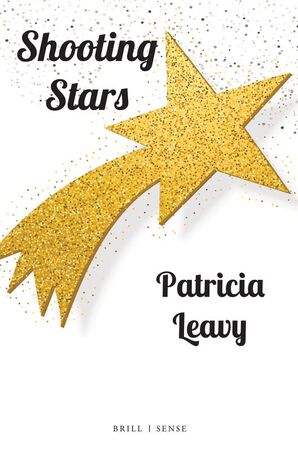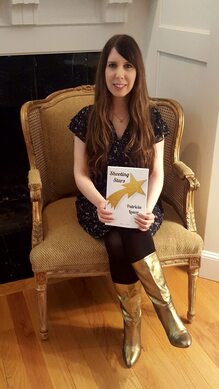|
For more than a decade, Dr. Patricia Leavy has been writing fiction as a means of addressing and teaching sociological subject matter both within and outside of the academy. Dr. Leavy’s latest novel, Shooting Stars, has received rave endorsements from renowned sociologists and academics across the disciplines, each urging professors to teach with the book and lay citizens to pick it up for casual reading. The first novel in what will become a serial, it is perhaps her most ambitious project and has been called her “most powerful work to date” among other praise. Shooting Stars is an epic love story about how love can help us heal from past trauma. We’ve spoken with Dr. Leavy many times over the years and recently had a chance to chat about her bold new novel.
How would you describe Shooting Stars? At the core it’s a love story. In the first chapter Tess Lee, an inspirational novelist, and Jack Miller, a federal agent, meet in a bar. Their connection is palpable. She examines the scars on his body and says, “I’ve never seen anyone whose outsides match my insides.” The two embark on an epic love story that asks the questions: What happens when people truly see each other? Can unconditional love change the way we see ourselves? Their friends are along for the ride and through these relationships we see love in many different forms. Shooting Stars is a novel about walking through our past traumas, moving from darkness to light, and the ways in which love – from lovers, friends, or the art we experience – heals us. I’ve written it as unfolding action, no interiority or flashbacks, so readers experience the characters as they experience each other. Tonally, the book moves between melancholy, humor, and joy. 
What inspired you to write this novel?
I think I always write what I want to read—something that will hold my hand and help me get from one place to another. This novel came to me in a bolt and unlike anything I’ve done before, I wrote the entire first draft in only ten days. It was the most immersive, engaging, cathartic, and joyful experience of my creative life. I believe it came to me quickly because it was buried deep within. Since I was a child I wanted to write a love story about people who help each other heal from past hurt, something innately human. More than just writing about romantic love, I wanted to explore all kinds of love—between lovers, between friends, love of country, and the love we experience through art. Whatever the question is, surely love is part of the answer so I want to write about some of the beauty and messiness. What does unconditional love actually look like and feel like? In this story world, like in life, it encompasses coziness, closeness, grace, humor, pain, suffering, and joy. Interpersonal relationships are central to this book. Talk about the primary relationship between Tess and Jack. Before meeting each other, Tess and Jack had each gone without a certain kind of love. Tess was able to see and care for every stranger she met, but wasn’t ready for one-on-one love, in part due to childhood trauma. Jack was unable to have personal relationships for most of his adult life due to the nature of his job. He was struggling with the residue of violence that remains after spending two decades confronting the worst of humanity and he was simultaneously dealing with grief over a profound loss. From the moment they meet, they share a connection. Without saying a word about it, they both decide to love each other with everything they have. It’s a really beautiful relationship. There’s a saying that "hurt people hurt people" but sometimes that’s not the case. Sometimes people in pain are able to love others in extraordinary ways, and they only hurt themselves, until the unconditional love of those who truly see them, allows them to move through their pain. The love between Tess and Jack is beautiful, pure, and unconditional. They see each other. I think through their relationship we can see what love looks like in action, day to day. The friendship between Tess and her best friend, Omar, is the other central relationship. He calls her “Butterfly” for reasons revealed in the last chapter. This is another beautiful example of a loving relationship. How would you describe it? Friendships are vitally important in people’s lives and at times in popular culture they play second fiddle to romantic relationships. I wanted to challenge that. Sometimes our soul mate isn’t a lover, but a dear friend who sees and understands us. Tess and Omar share a special closeness that I hope illustrates what deep friendship looks like in action. They care for each other profoundly, have made sacrifices for one another, and are in every meaningful respect “family.” I tried to bring their relationship to life both through tender moments, but perhaps even more so through shared laughter and a shared history of their choosing. Omar is wickedly funny and is able to move fluidly from humor to earnestness as needed in his interactions with others. I’ve learned a lot from this friendship about how we might treat, honor, and value one another. Other than Tess, nearly all the characters in Shooting Stars are male which is a departure from your earlier work. Popular culture is filled with examples of toxic masculinity, and I wanted to create just the opposite. I think an important part of cultural critique is to create alternatives and reimagine how things might be. The characters in this novel represent several different versions of masculinity that embody strength, compassion, and demonstrate an ethics of care for others. They are role models. While dark male forces lurk in the background and are central to the story, the characters readers come to know are just the opposite. In addition to childhood abuse and trauma, a range of sociological issues are addressed. The characters are racially diverse and an incident of police racial profiling comes up in the first chapter. Homeless people appear throughout the book, and in one instance the person is named. Misogyny, including the oppression of women from the US to the Middle East comes up. None of this is in the foreground, but it’s all there, carefully woven into what on the surface is an epic love story. Why did you include references to these phenomena? We all live our stories in a larger world. I wanted to paint a picture of what that world looks and feels like, even if only briefly referenced in the background. This is also ultimately a story about traumas we don’t talk about. It’s about profound pain people carry that’s so real and consequential it’s palpable, and yet it may be completely invisible. I wanted to make visible what is often relegated to the silent darkness. So, for example, when Tess sees a homeless person, she truly sees them, engages with them, holds their hands. It’s literal, but it’s also symbolic and metaphoric. What do you hope readers take away from this book? Healing is possible. Love is possible. Healing is possible if we let love into our lives, whether that love comes from friends who get us, lovers who truly see us, or the art we make or experience, like a song, a movie, or even a novel. We can learn to balance darkness and light in our lives.
Who is the audience for Shooting Stars?
Anyone can read it on their own or in book clubs. That’s the great thing about fiction. Whether you’re looking for a love story, a narrative about healing, or something that is ultimately hopeful, I hope the book has something to offer you. My fondest hope is that professors use it in their classes. As a sociologist I write from a particular perspective. I wrote Shooting Stars with the hopes it would be used in a range of course in sociology, psychology, social work, communication, and other disciplines to address topics ranging from interpersonal relationships to trauma and healing. I’ve included discussion questions and writing, research, and art activities to assists professors who wish to incorporate it into their classes. The further engagement is merely meant to stimulate ideas about any number of ways the novel might be integrated into courses. The novel also includes an author Q&A which might provide useful in classroom or book club settings. The back cover says, “A Tess Lee and Jack Miller novel.” What can we expect from the other books in the serial? Five books have been written in total, each taking place a year after the previous one. Each Tess Lee and Jack Miller novel explores love at the intersection of another theme; in Shooting Stars the theme I explore is love and healing. The next book explores love and doubt. By the time we move through the series, the major issues that I think plague our relationships, including the one we have with ourselves, are addressed. As the characters move through them toward greater healing, connection, and joy, I hope readers do as well. The series as a whole is love letter to love, in all its forms. Any advice for sociologists looking to write fiction? Read a lot of fiction and take note of what speaks to you. Pick a genre and topic you would want to read. If it’s a passion project, you will see it through. When the writing engages you, it’s also more likely to do that for others. Begin from where you are. Your sociological lens is a tool you can bring to the craft of fiction, for example, in crystalizing micro-macro links. Have confidence that your unique perspective will guide you. It’s good to develop a discipline around creative writing so that you work on your craft even when it’s hard. Most fiction doesn’t come from a bolt of inspiration, but rather sitting down and plugging away. Even in the case of Shooting Stars, while the first draft came quickly, it was followed by months of editing, recrafting, ascertaining feedback, and revising. Practice, play, and have fun with it.
-------------------------------
Rogil
8/14/2020 11:27:08 am
Good work Comments are closed.
|
.
.
Tags
All
|


 RSS Feed
RSS Feed